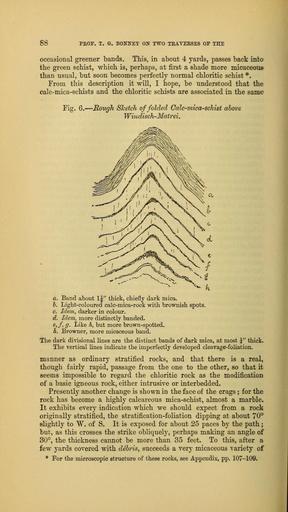MAKE A MEME
View Large Image

| View Original: | The_Quarterly_journal_of_the_Geological_Society_of_London_(13936980211).jpg (1182x2101) | |||
| Download: | Original | Medium | Small | Thumb |
| Courtesy of: | commons.wikimedia.org | More Like This | ||
| Keywords: The Quarterly journal of the Geological Society of London (13936980211).jpg 90 PROF T G BONNET ON TWO TEA VERSES OF THE <br> the range These rocks have a marked resemblance to the Lepon- <br> tine gneiss of the Central Alps I wrote in my diary ” The <br> rocks seen at the head of the Gschlossthal vary in aspect from the <br> i Antigorio ' gneiss through the Monte Leone gneiss to that of the <br> pass of St Gothard but I have seen nothing which resembles the <br> Tremola schists <br> The strong-banded micaceous and hornblendic gneisses mentioned <br> above are traversed on the ascent to the Yelber-Tauern pass My <br> observations of the foliation which is often associated with mineral <br> banding give strikes varying from E N E to E S E with a moderate <br> dip say about 25° on the southern side ; but there are frequent <br> indications of rolling and twisting for higher up the dips vary from <br> the southern to the northern side and north-westerly strikes seem <br> to predominate As we approach the crest of the pass the beds are <br> more coarsely crystalline and may be true granites ; they show a <br> certain foliation but not mineral banding On the upper part of the <br> descent towards the north we meet with a considerable amount of <br> hornblendic rock HornblendescMefer V II sometimes dark some- <br> times spotted with white felspar occasionally rather coarse <br> slightly foliated or now and then even banded varying from massive <br> to rather platy in structure on the whole very like some of the horn- <br> blende-rock in the Hebridean series Very much if not all may be <br> modified igneous rock which hypothesis is confirmed by the outlines <br> of the outcrops indicated on the map Some distance from the top of <br> the pass we noticed that in the crags on the left bank of the upland glen <br> which we were descending masses of rock probably from 50 feet to <br> about 300 feet thick exhibited a kind of stratification indicated by <br> differences of tint and these dipped clearly northwards at perhaps an <br> average angle of 40° Beyond this the bed of the glen is interrupted by <br> a range of cliffs The bottom of the slope is reached by a rapid and <br> rough descent in a north-westerly direction during which we ob- <br> served that the mica now and then became more silvery and the <br> rock as a whole assumed a less ancient aspect On reaching the <br> bottom the scenery changes the stream becoming bordered by sloping <br> pastures and copses and no rock was seen in situ till after passing <br> the Pinzgauer Tauernhaus 3 5-30 feet when a rather fissile chloritic <br> schist crops out Hence to near Mittersill little rock is seen what <br> there is being either the normal chloritic schist or green rock of a <br> not very definite character The lateral torrents however bring <br> down blocks of fine-grained rather banded gneisses darker and <br> lighter of various gneisses and schists approaching the Lepontine <br> type with some which appear to belong to the Thonglimmerschiefer <br> series ; but shortly before reaching Mittersill we traverse in a shallow <br> gorge a considerable mass of chloritic schist with a high dip towards <br> the north Appendix p 108 It is somewhat calcareous and corre- <br> sponds with the green schists in the glen north of Windisch-Matrei <br> According to Yon Hauer's map the associated group of calcareous <br> micaceous and chloritic schists extends continuously round the <br> eastern edge of the Central- Gneiss massif passing from Windisch- <br> Matrei by the head of the Mollthal to the valley of the Salza in <br> which among level water-meadows Mittersill is situated 36939871 113696 51125 Page 88 Text 45 http //www biodiversitylibrary org/page/36939871 1889 Geological Society of London Biodiversity Heritage Library The Quarterly journal of the Geological Society of London v 45 1889 Geology Periodicals Smithsonian Libraries bhl page 36939871 dc identifier http //biodiversitylibrary org/page/36939871 smithsonian libraries Information field Flickr posted date ISOdate 2014-04-21 Check categories 2015 August 26 CC-BY-2 0 BioDivLibrary https //flickr com/photos/61021753 N02/13936980211 2015-08-26 06 53 22 cc-by-2 0 PD-old-70-1923 The Quarterly journal of the Geological Society of London 1889 Photos uploaded from Flickr by Fæ using a script | ||||